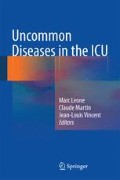Abstract
Toxic epidermal necrolysis (TEN) is a diagnostic emergency. Management of this disease should take place in a specialised centre. The usual causative drugs in children are sulphonamide antibiotics, antiepileptics and non-steroidal anti-inflammatory drugs. Causative drugs should be stopped definitively and as quickly as possible. Treatment consists essentially of hydroelectrolytic replacement, nutritional support, analgesia and use of sterile dressings. Systemic immunosuppressive treatments and plasmapheresis may be used. Treatment of mucosal attacks (oral, ocular and genital in particular) is essential to limit long-term sequellae. Psychological support should also be considered.
Access this chapter
Tax calculation will be finalised at checkout
Purchases are for personal use only
References
Borchers AT, Lee JL, Naguwa SM et al (2008) Stevens-Johnson syndrome and toxic epidermal necrolysis. Autoimmun Rev 7:598–605
Koh M, Tay Y (2009) An update on Stevens-Johnson syndrome and toxic epidermal necrolysis in children. Curr Opin Pediatr 21:505–510
Levi N, Bastuji-Garin S, Mockenhaupt M et al (2009) Medications as risk factors of Stevens-Johnson syndrome and toxic epidermal necrolysis in children: a pooled analysis. Pediatrics 123:e297–e304
Mayes T, Gottschlich M, Khoury J (2008) Energy requirements of pediatric patients with Stevens-Johnson syndrome and toxic epidermal necrolysis. Nutr Clin Pract 23:547–550
Schneck J, Fagot J, Sekula P et al (2008) Effects of treatments on the mortality of Stevens-Johnson syndrome and toxic epidermal necrolysis: a retrospective study on patients included in the prospective EuroSCAR Study. J Am Acad Dermatol 58:33–40
Sotozono C, Ueta M, Koizumi N et al (2009) Diagnosis and treatment of Stevens-Johnson syndrome and toxic epidermal necrolysis with ocular complications. Ophthalmology 116:685–690
Author information
Authors and Affiliations
Corresponding author
Editor information
Editors and Affiliations
Rights and permissions
Copyright information
© 2014 Springer International Publishing Switzerland
About this chapter
Cite this chapter
Michel, F. (2014). Toxic Epidermal Necrolysis in Children. In: Leone, M., Martin, C., Vincent, JL. (eds) Uncommon Diseases in the ICU. Springer, Cham. https://doi.org/10.1007/978-3-319-04576-4_17
Download citation
DOI: https://doi.org/10.1007/978-3-319-04576-4_17
Published:
Publisher Name: Springer, Cham
Print ISBN: 978-3-319-04575-7
Online ISBN: 978-3-319-04576-4
eBook Packages: MedicineMedicine (R0)

